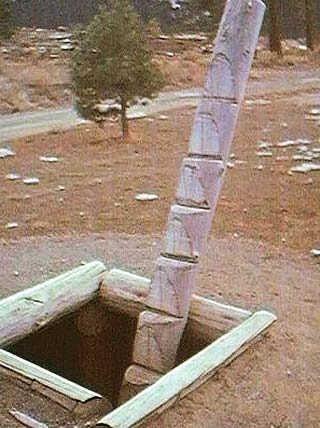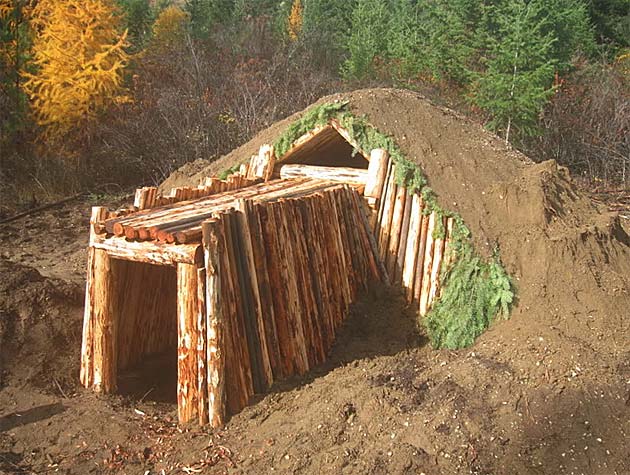 |
Originals were mostly built of cedar, as this wood is easily split and saws were yet to be invented. Circular in shape, an opening in the top was used as a smoke escape. For most original quiggly holes, a ladder was used to enter the dwelling from this opening as well. You might compare quiggly holes to modern day root cellars. Many people used these dwellings as storage for food that had been gathered and prepared for winter storage. Others used them as make shift kitchens. Making quiggly holes was not that difficult. It consisted of carving out the earth in a round, circular manner. Logs were used to create the dome shaped roof. The size of the home was often determined by the length of the trees being used. Sometimes they were constructed for just one person, but other times, groups of families would chip in and build a large one together, easing the workload on each person. Because these homes were actually built INTO the earth, they appear from the surface as circular indentations in the ground. Original quiggly holes were often built in clusters, forming towns or villages, indicating there was a huge population of these people at one point in time. These clusters were built close to game and water, making it easy for people to gather food. It is believed some of the quigglies may have been communal property, used for gatherings, rituals and healings. It is also believed the closer the quiggly is to the center of the village, the more prominent or important, the family was.
The landscape of southern British Columbia is dotted with these homes and other lean-tos used by The First Nations. Fort Chilcotin is a site in Hudson's Bay Flats and is home to the oldest gathering of quiggly holes. There is also a quiggly town in the Frazer Canyon and that has about 115 quiggly holes. Archaeological investigators have spent a great deal of time there, trying to figure out why the village was abandoned. The conclusion was the villagers decided to flee when a slide collapsed, causing a lake to form from the river, forcing them out. Preserving quiggly holes is important for history, but also has significance for The First Nation, as it shows ownership of land, and ongoing struggle. Although no longer in use, viewing these lodges can give us a sense of what life was like back then and a glimpse into the world of these long-ago, almost forgotten earth dwellers. Why not build your own modern day quiggly hole? It may not fit your requirements for a main resident, but it may just make for a good getaway into nature.
|
|
|
© 2021 EarthHomesNow.com.
All Rights Reserved.
|



